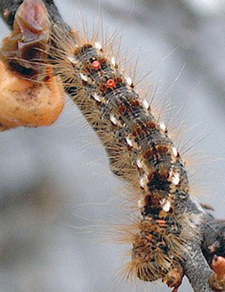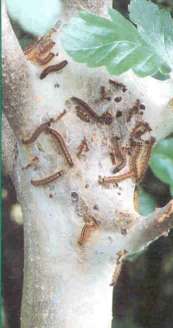How to Get Rid of Brown Tail Moth Caterpillars
This page gives you advice and information on how you can help to prevent a spread of the Brown Tail Moth and prevent you and your family suffering from the painful rash that the caterpillars cause. It will also help you to identify the Lackey Moth - a less harmful caterpillar with characteristics easily confused with the Brown Tail Moth.
As you can see from the photograph, the caterpillar of the Brown Tail Moth is brown, has a dotted white line down each side and two very distinctive red dots on the back of its tail.


Why is it such a problem?
It is a voracious eater of vegetation, especially in the spring, and although it prefers hawthorn and blackberry, it will eat practically any type of tree or bush. Heavily infested trees are weakened by the loss of foliage, consequently growth is poor and fruits fail to mature for several seasons which is a problem for the gardener, but the caterpillar also releases irritant hairs into the air which can cause skin irritation, and can affect some people quite severely.
How do I know if I have an infestation in my garden?
First of all by seeing individual caterpillars or areas of trees or bushes that has lost all their leaves where the caterpillars have been feeding. The caterpillars live in groups and you may also see the communal "tents" which they use mainly for shelter from bad weather but also for hibernation in the winter. These clumps of cobweb like material will release irritant hairs when disturbed, it is important, therefore to take protective measures when carrying out any treatment.
Does the Council treat them?
Unfortunately not unless the moths are on Council Owned Land. If the land is privately owned, it is the responsibility of the landowner. If the moths are causing a nuisance, the Council can force the landowner to remove the moths however this is a last resort.
The Brown Tail Moth caterpillar is not recognised public health pest therefore the council and most Local Authorities doe not provide such a service.
Note if on Council Owned Land, refer to Leisure 01255 686677
Can I treat them myself?
Yes, depending on the time of the year you can carry out treatment but you must take adequate protective measures to avoid skin irritation.
May and June
The caterpillars emerge particularly during warm weather and can be treated when they are out of their nests using a chemical spray. The most suitable and widely available chemical is called a Pyrethoid and is sold under various names at garden centres and chain stores. It is not effective when the caterpillars return to their nests in the evening and during bad weather. At these times it is much better to physically remove the nest using secateurs to cut them and drop them into a plastic bag which should be sealed and either burnt, if it is safe to do so, or sealed in a second plastic bag and put in the dustbin.
If you choose the burning option, please take into consideration your neighbours.
September and October
The caterpillars re-emerge and although not so apparent as in the spring, their feeding will cause leaves at the top of the tree or shrub to turn brown. They can be very effectively dealt with by the methods described above.
Winter
They stay in their tents and as the leaves drop these become very visible. The tents can be cut out at this time of the year but the insecticide spray is largely ineffective.
Remember always take proper precautions when carrying out treatment
What precautions should I take?
There are a number of precautions you should always take when carrying out a treatment.
Always wear thick clothing, rubber gloves, wellington boots and as far as possible cover all bare skin. If you are spraying insecticide follow the manufacturer's instructions and recommended safety measures. Always spray when the weather is fine and there is no wind or rain to avoid drift or run-off problems. It is also advisable to wear goggles. If you are using a ladder, either lash the ladder to the tree or get someone to stand at the foot of the ladder. Protective clothing should be thoroughly rinsed in clean water after use as the irritant hairs will adhere to it.
In contrast to the Brown Tail Moth, the Lackey Moth caterpillars are black in colour when they first appear in April, but soon develop blue, white and orange stripes with an overall covering of reddish/brown hairs. They are communal insects and tend to live in colonies for most for their lives constructing thick webs of silk (tents) mainly for protection. See picture below.
The caterpillars feed on the foliage of a variety of trees and shrubs causing similar levels of damage, but when disturbed do not release hairs that may cause skin irritation or present a hazard to health.
The caterpillars within easy reach can be destroyed by waiting until they have congregated in one spot and using rubber gloves, scoop them into a plastic bag which is then sealed and disposed of in the same way as the Brown Tail Moth caterpillars. In winter, the egg bands are not difficult to see and can be collected at the same time as pruning before the caterpillars emerge. When large numbers of trees are affected or they are out of reach from ground level, chemical spraying methods used to treat Brown Tail Moth should be employed.
What if I don't want to clear it myself?
Most pest control contractors can clear the caterpillars. Tendring District Council uses Pest Clear who can be contacted on 01255 433999 or you may locate one in a directory.
What if I get a rash?
If you are unfortunate to get a rash, it will only normally last 2-3 days. During this time it will be very irritable but you should not scratch. Some of the relief can be contained by applying calamine lotion. If the rash persists, see your doctor.
Tendring District Council's Pollution and Environment Team has produced a PDF Leaflet which you can download.
How to Get Rid of Brown Tail Moth Caterpillars
Source: https://www.tendringdc.gov.uk/environment/dogs-animals-pests/pest-control/brown-tail-moth-caterpillar